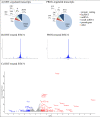Transcriptome profiling and proteomic validation reveals targets of the androgen receptor signaling in the BT-474 breast cancer cell line
- PMID: 35568821
- PMCID: PMC9107748
- DOI: 10.1186/s12014-022-09352-2
Transcriptome profiling and proteomic validation reveals targets of the androgen receptor signaling in the BT-474 breast cancer cell line
Abstract
Background: Accumulating evidence suggests that the androgen receptor (AR) and its endogenous ligands influence disease progression in breast cancer (BCa). However, AR-mediated changes in BCa differ among the various BCa subtypes according to their hormone receptor profile [i.e., presence/absence of estrogen receptor (ER), progesterone receptor (PR) and human epidermal growth factor receptor 2, (HER2)]. Thus, we explored the androgen-regulated transcriptomic changes in the ER+PR+HER2+ BCa cell line, BT-474, and compared them with PR-mediated changes.
Methods: We performed RNA sequencing analysis in treated BT-474 cells with dihydrotestosterone (DHT) and progesterone. Validation of the top ten differentially androgen-regulated genes and a number of other genes found in enriched signaling pathways was performed by qRT-PCR in BT-474 and other BCa cell lines. In addition, a parallel reaction monitoring targeted proteomic approach was developed to verify selected transcripts at the protein level.
Results: In total 19,450 transcripts were detected, of which 224 were differentially regulated after DHT treatment. The increased expression of two well-known androgen-regulated genes, KLK2 (p < 0.05) and KLK3 (p < 0.001), confirmed the successful androgen stimulation in BT-474 cells. The transcription factor, ZBTB16, was the most highly upregulated gene, with ~ 1000-fold change (p < 0.001). Pathway enrichment analysis revealed downregulation of the DNA replication processes (p < 0.05) and upregulation of the androgen signaling and fatty acid metabolism pathways (p < 0.05). Changes related to progesterone treatment showed opposite effects in gene expression than DHT treatment. Similar expression profiles were observed among other BCa cell lines expressing high levels of AR (ZR75.1 and MBA-MB-453). The parallel reaction monitoring targeted proteomic analysis further confirmed that altered protein expression (KLK3, ALOX15B) in the supernatant and cell lysate of DHT-treated BT-474 cells, compared to control cells.
Discussion: Our findings suggest that AR modulates the metabolism of BT-474 cells by affecting the expression of a large number of genes and proteins. Based on further pathway analysis, we suggest that androgen receptor acts as a tumor suppressor in the BT-474 cells.
Keywords: Androgen receptor; BT-474; Breast cancer; Metabolism; RNA sequencing; Sex hormones; Transcriptome.
© 2022. The Author(s).
Conflict of interest statement
The authors declare that they have no competing interests.
Figures









Similar articles
-
Androgen receptor: A promising therapeutic target in breast cancer.Crit Rev Clin Lab Sci. 2019 May;56(3):200-223. doi: 10.1080/10408363.2019.1575643. Epub 2019 Mar 1. Crit Rev Clin Lab Sci. 2019. PMID: 30821186 Review.
-
Anti-proliferative transcriptional effects of medroxyprogesterone acetate in estrogen receptor positive breast cancer cells are predominantly mediated by the progesterone receptor.J Steroid Biochem Mol Biol. 2020 May;199:105548. doi: 10.1016/j.jsbmb.2019.105548. Epub 2019 Dec 2. J Steroid Biochem Mol Biol. 2020. PMID: 31805393
-
Regulation of androgen receptor gene expression by steroids and retinoic acid in human breast-cancer cells.Int J Cancer. 1992 Nov 11;52(5):778-84. doi: 10.1002/ijc.2910520518. Int J Cancer. 1992. PMID: 1428232
-
Characterization of androgen receptor and nuclear receptor co-regulator expression in human breast cancer cell lines exhibiting differential regulation of kallikreins 2 and 3.Int J Cancer. 2002 Aug 10;100(5):507-14. doi: 10.1002/ijc.10520. Int J Cancer. 2002. PMID: 12124798
-
Androgen receptor signaling pathways as a target for breast cancer treatment.Endocr Relat Cancer. 2016 Oct;23(10):R485-98. doi: 10.1530/ERC-16-0190. Epub 2016 Aug 15. Endocr Relat Cancer. 2016. PMID: 27528625 Review.
Cited by
-
Arachidonate 15-lipoxygenase type B: Regulation, function, and its role in pathophysiology.Front Pharmacol. 2022 Nov 9;13:1042420. doi: 10.3389/fphar.2022.1042420. eCollection 2022. Front Pharmacol. 2022. PMID: 36438817 Free PMC article. Review.
-
Proteomics-Based Identification of Dysregulated Proteins in Breast Cancer.Proteomes. 2022 Oct 21;10(4):35. doi: 10.3390/proteomes10040035. Proteomes. 2022. PMID: 36278695 Free PMC article. Review.
-
Androgens Modulate Bcl-2 Agonist of Cell Death (BAD) Expression and Function in Breast Cancer Cells.Int J Mol Sci. 2023 Aug 30;24(17):13464. doi: 10.3390/ijms241713464. Int J Mol Sci. 2023. PMID: 37686282 Free PMC article.
References
-
- American Cancer Society. How common is breast cancer? 2020. https://www.cancer.org/cancer/breast-cancer/about/how-common-is-breast-c.... Accessed 29 Dec 2020.
-
- Need EF, Selth LA, Harris TJ, Birrell SN, Tilley WD, Buchanan G. Research resource: interplay between the genomic and transcriptional networks of androgen receptor and estrogen receptor alpha in luminal breast cancer cells. Mol Endocrinol. 2012;26:1941–1952. doi: 10.1210/me.2011-1314. - DOI - PMC - PubMed
LinkOut - more resources
Full Text Sources
Molecular Biology Databases
Research Materials
Miscellaneous
